
________________
To inquire about a translation for this video message for a fee email: [email protected]
Category: Saudi Arabia
New video message from al-Batār Media Foundation: "The First Rain: Operation From the Supporters Of the Islamic State in Bilād al-Ḥaramayn (Saudi Arabia)"

__________
To inquire about a translation for this video message for a fee email: [email protected]
Check out my new 'Policy Alert' for The Washington Institute: "The Islamic State's Archipelago of Provinces"
![]()
This week, Abu Bakr al-Baghdadi, the leader of the Islamic State of Iraq and al-Sham, released a rare public message in which he declared the creation of several new “provinces” in various Arab countries. It was the first time that he and his organization have acknowledged groups that have pledged baya (religiously binding oath of allegiance) to the so-called “Islamic State” since the announcement of its “Caliphate” six months ago. The audio message offers insight into the group’s expansion model and its plans for exacerbating religious tensions between Sunnis and Shiites beyond Iraq, Syria, and Lebanon. Whether Western governments want to admit it or not, the reality is that the Islamic State has expanded in a non-contiguous manner outside its base and now has authority over satellite groups and small amounts of territory outside Iraq and the Levant.
Click here to read the rest.
New video message from the Islamic State’s Abū Bakr al-Ḥussaynī al-Qurayshī al-Baghdādī: “Although The Disbelievers Dislike It”
The title of this release is in reference to Qur’anic verses 9:32, 40:14, and 61:8.
—
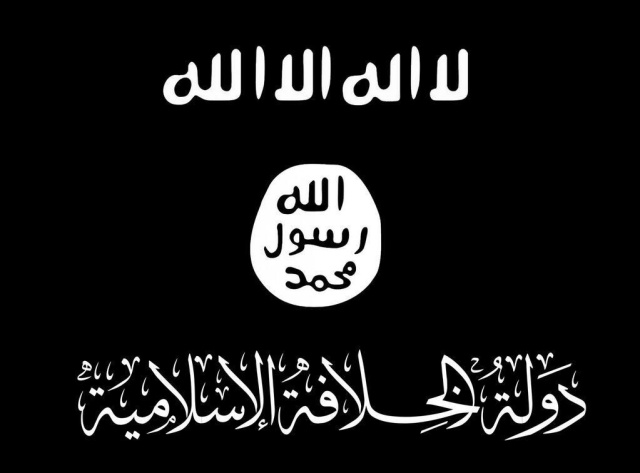
Audio:
Abū Bakr al-Ḥussaynī al-Qurayshī al-Baghdādī: “Although The Disbelievers Dislike It”
English Translation:
Abū Bakr al-Ḥussaynī al-Qurayshī al-Baghdādī — Although The Disbelievers Dislike It (En)
Hizballah Cavalcade: The Shia Militant Response to Ayatollah Nimr al-Nimr’s Death Sentence
NOTE: For prior parts in the Hizballah Cavalcade series you can view an archive of it all here.
—
The Shia Militant Response to Ayatollah Nimr al-Nimr’s Death Sentence
By Phillip Smyth
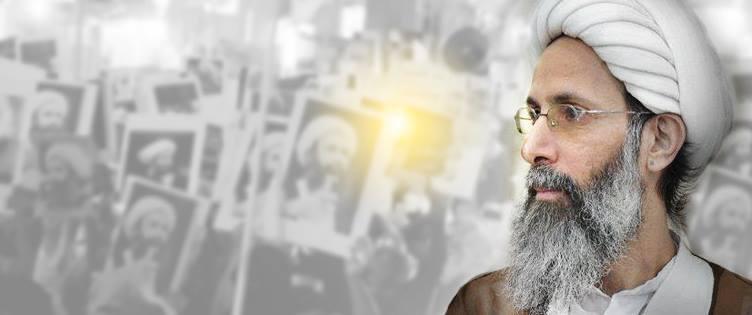
Ayatollah Sheikh Nimr Baqr al-Nimr, an outspoken radical Saudi Arabian Shia cleric, has been the center of controversy and brewing conflict between Shia protesters, militant Shia groups of Saudi Arabia and Bahrain, and their respective Sunni governments. According to a 2012 article by Toby Matthiesen, al-Nimr was, “long a peripheral figure in the local Shia power struggle but now seems to have become the most popular Saudi Shia cleric among local youth.”1 His cause and image is spreading across the Middle East as the latest example of Sunni oppression of Shia in the region and his recent death sentence has become a potent rallying cry for regional Shia militant organizations, particularly those with links to Iran.
Arrested in 2012, Nimr was accused by the Saudi government’s Special Criminal Court of making sectarian statements to cause strife, inviting foreign intervention (shorthand for Iranian influence), and disobeying the king. Following his 2012 arrest, thousands took to the streets and Saudi police shot and killed two protesters.2 In mid-October 2014, Nimr was sentenced to be “crucified”, a process where the sheikh will be beheaded and his body displayed.3
Protests in Saudi began in early 2011 and in part addressed anti-Shia discrimination suffered by the group in the Shia majority area in Saudi Arabia’s oil-rich Eastern Province; primarily zones around the Shia-majority towns and villages near the city of Qatif.4 Following the 2011 Saudi intervention in Bahrain, protests against the Saudi government increased in Bahrain and Saudi Arabia among Shia protesters.5 Following the 2011-2012 protests, links between Bahrain’s and Saudi Arabia’s protest movement spilled over into the more militant circles which actively promoted Nimr’s defiant stance and a hope to combine their fronts against common foes.
Of further interest are Nimr’s own ideological leanings and how they may relate to Shia militant responses. In Frederic Wehrey’s Sectarian Politics in the Gulf, the sheikh is described as a follower of the late Ayatollah Muhammad al-Shirazi.6 Shirazi was one of the founders of a radical Shia political school of thought referred to as the “Shiraziyya.” Shiraziyya clerics have been some of the most influential in the Arab Shia world. Initially al-Shirazi agreed with the Islamic revolutionary ideology of Ayatollah Khomeini, only to split from Khomeini over issues regarding how the new Islamic state (in Iran post 1979 revolution) should be led.7 In one BBC Arabic report, Nimr had been accused by Riyadh of attempting to spread Wilayat al-Faqih.8 Absolute Wilayat al-Faqih is the Khomeinist concept that serves as the basis for the Islamic Republic of Iran. Nevertheless, it was not clarified whether this was the type of Wilayat al-Faqih Nimr was accused of propagating.
Despite the history of strife between Shirazi’s school of thought and that of Ayatollahs Khomeini and Khamenei, al-Nimr appeared to increase public support for Tehran and send other more mixed messages. In 2008, he had also reportedly stated he supported Iran’s nuclear program by saying any attack against it should be met by a response from the Islamic world. That same year, he also said that Saudi Shia may need to call on foreign support (implying Iran) to help press their issues in Saudi Arabia.9 Later in 2009, Nimr reportedly called for secession, stating during a sermon, “Our dignity is more precious than the unity of this land.”10 His statement came as a response to discrimination against Shia in the kingdom and reflected possible repercussions if certain demands made by Shia protesters were not addressed.
Since 2013, in a piecemeal fashion, social media accounts associated with Iranian proxy groups in Iraq have promoted the images and other supportive statements for Ayatollah Nimr al-Nimr.11 While this does not necessitate that Nimr is a true ally or proxy of Tehran, his message and influence is likely seen by Iran as a cause to be promoted in that country’s wider struggle for the leadership of Shia Islam and as a counter to Saudi Arabia.
Nimr’s deep links and strong voice within the Saudi Shia community, particularly among youthful radicals and other more non-violent protestors, has led to Shia militant groups championing his cause from Bahrain and Iraq. Even in Yemen, Shia supporters of Ansar Allah, more commonly known as the Houthis, even launched demonstrations for the jailed cleric.12 Some Bahraini militant groups, which view the struggle of their coreligionists in a geographically close region of Saudi Arabia, as part and parcel to their conflict with the Khalifa monarchy and their Saudi government supporters. Additionally, powerful Iranian proxy groups based in Iraq—which have also maintained anti-Saudi and anti-Bahraini government narratives—have taken to issuing stern threats against Riyadh for his sentence.
The Violent Replies From Saudi Arabia’s and Bahrain’s Militants
Bahraini militant groups demonstrated the most concerted effort in terms of orchestrating violent retorts to Nimr’s jailing and sentence. While other threats and attacks were conducted since the start of 2014, this piece will focus on more recent threats and attacks beginning in the summer of 2014.
Bahrain’s Saraya al-Mukhtar (SaM), a group which once said the Saudi Shia of the Qatif and the Shia of Bahrain constituted one people with common foes, launched the most attacks over the longest period specifically addressing Ayatollah Nimr al-Nimr’s arrest, trial, and death sentence.
Starting in August, SaM attacked an electricity tower in Ar-Rifā near a Bahraini military base. The group filmed the attack and stated it had been a warning related to the imprisonment and trial of Ayatollah Nimr al-Nimr. Around the same time, SaM also began an online countdown for the Nimr verdict and increased their threats against Saudi Arabia. The group also ratcheted up it’s pro-Nimr messaging with the release of numerous images.
This messaging coincided with Saraya al-Mukhtar making its first direct threat against U.S. military personnel in Bahrain on August 11. Through an image posted to Facebook, SaM stated that, “The American cover on al-Saud and Al_Khalifa crimes,,Marines in bahrain will pay the price. [sic]” The message essentially claimed that the U.S. was the real backer for the Khalifa and Saud monarchies. As a result, they bore equal responsibility and could be targeted.
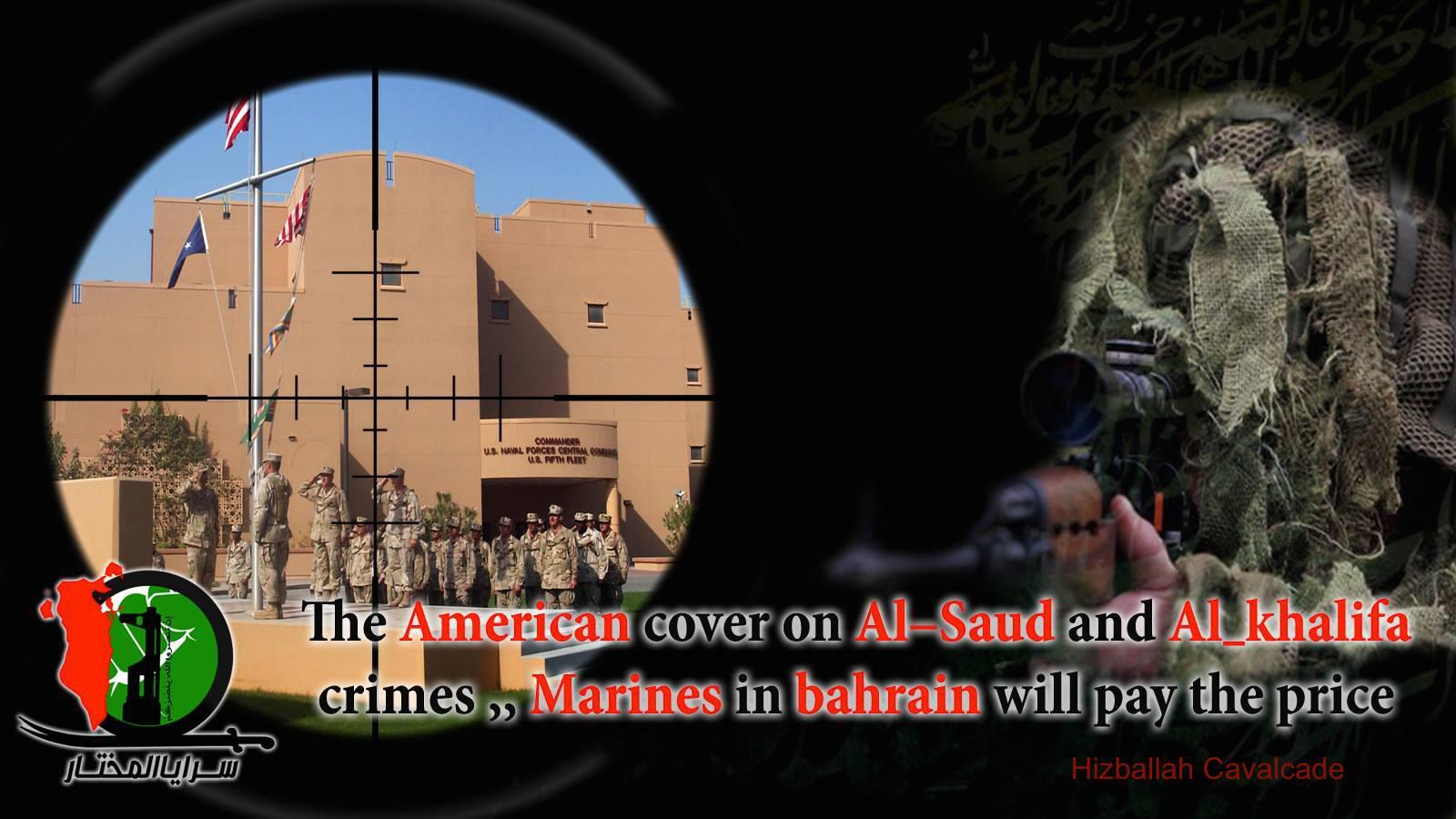
Figure 1: Saraya al-Mukhtar’s anti-American message posted on August 11, 2014.
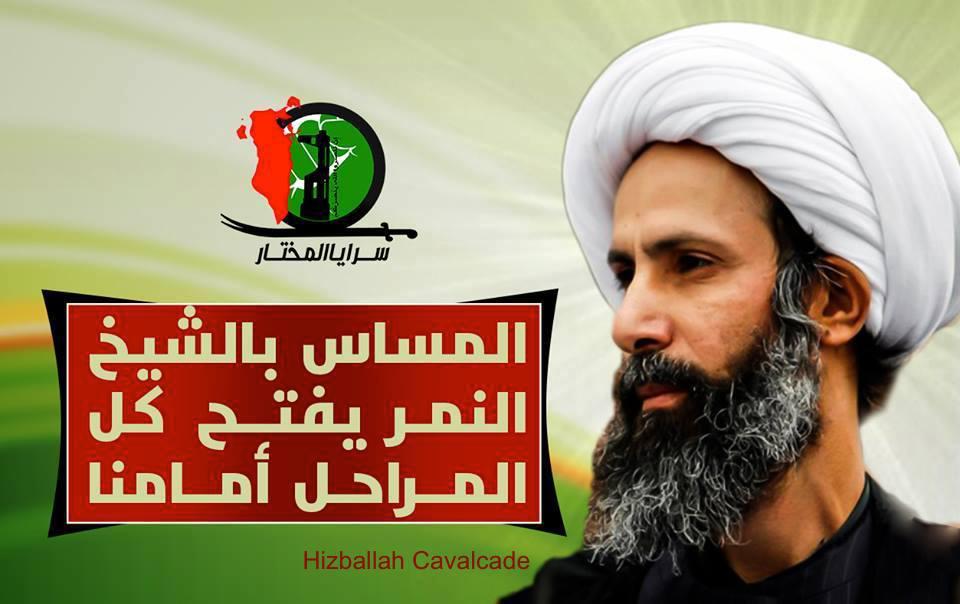
Figure 2: A Saraya al-Mukhtar photo for Ayatollah Nimr al-Nimr posted on August 8, 2014. The poster reads: “Sheikh Nimr[‘s trial and poor treatment] will make us put all options on the table.”
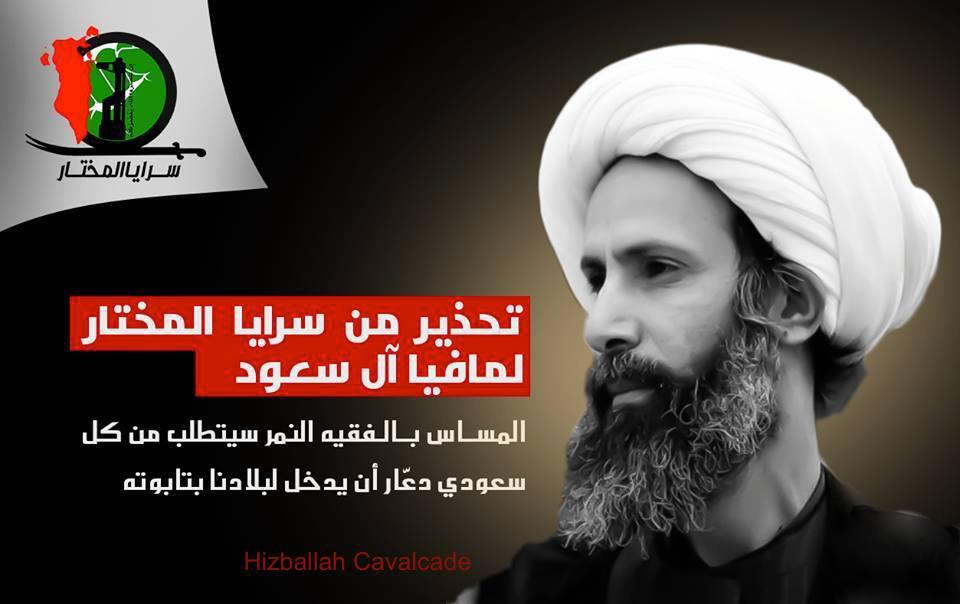
Figure 3: A Saraya al-Mukhtar photo posted on August 10, 2014. This poster reads: [in the red box] “A warning from Saraya al-Mukhtar to the mafia of the Sauds [in white text] Harming Sheikh Nimr will make us put all options [on the table]. Harming the Faqih Nimr means every single Saudi national will enter our country in a coffin.”
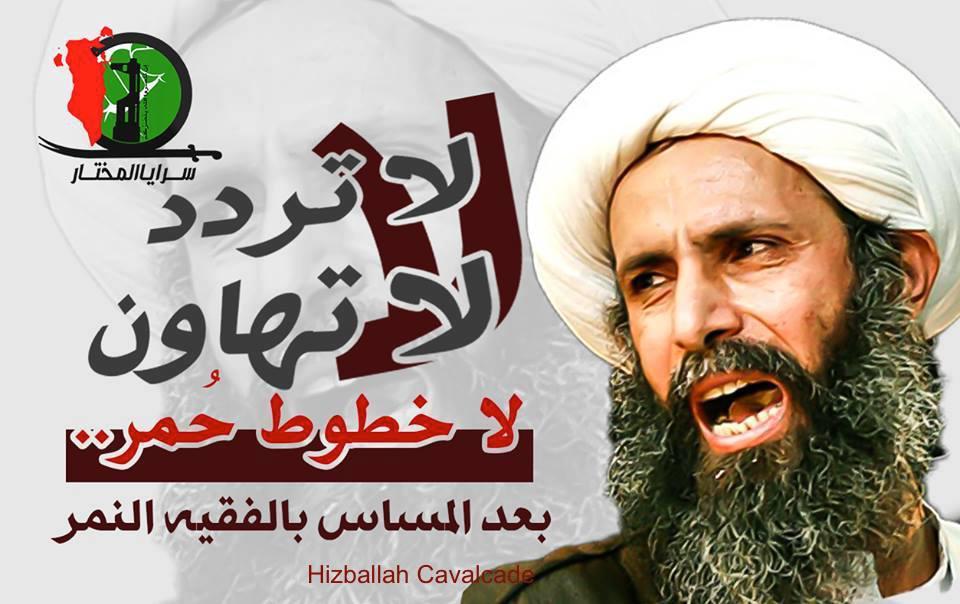
Figure 4: A Saraya al-Mukhtar photo for Ayatollah Nimr al-Nimr posted on August 11, 2014. The poster reads: “Do not hesitate, Do not underestimate, No red lines.. after [the] discrimination [against] the Faqih al-Nimr.”
On September 16, SaM announced it had planted 6 explosive devices in retaliation for al-Nimr’s incarceration. Albeit, these bombs did not target U.S. interests and there was little confirmation as to whether any devices were actually planted.

Figure 5: Saraya al-Mukhtar’s September 16 claim to have planted 6 bombs.
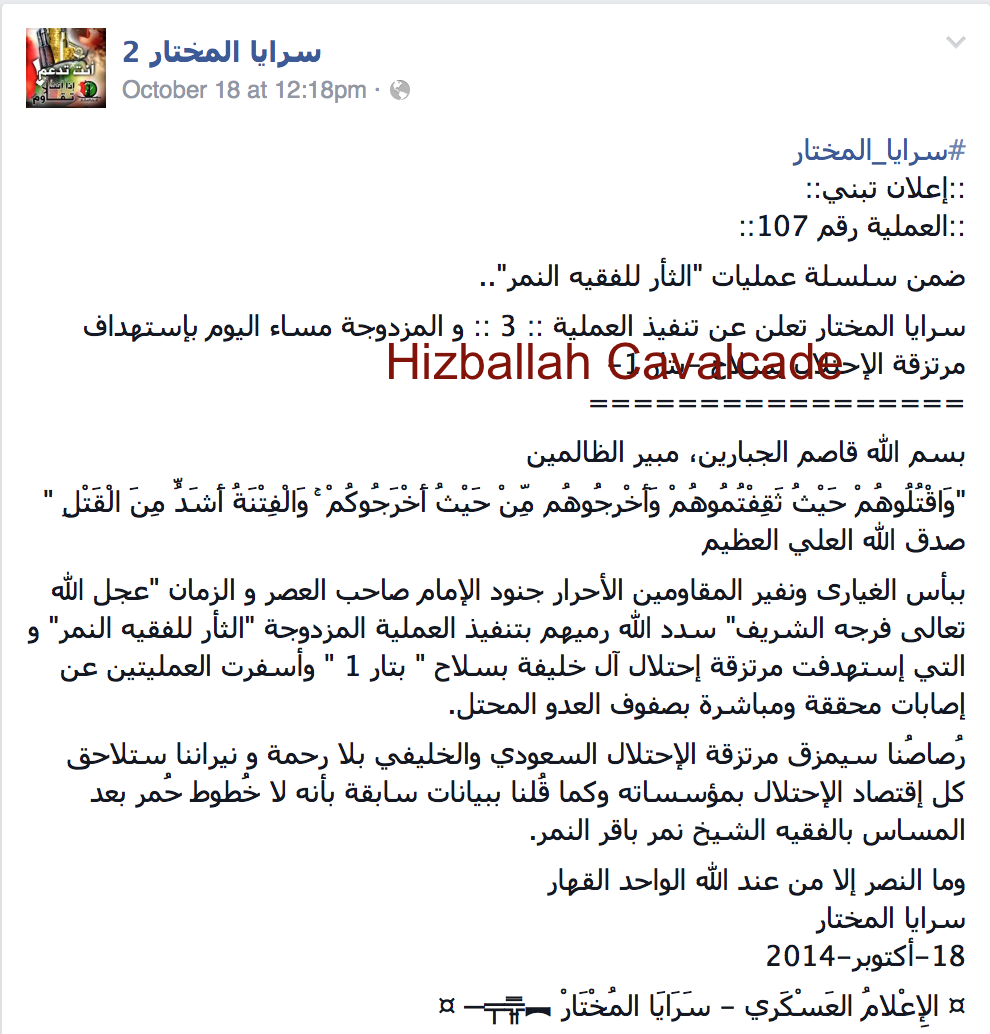
Figure 6: Saraya al-Mukhtar’s claim of 2 attacks on October 18, 2014.
Then on October 9, SaM claimed to conduct an attack in the town of Karana, Bahrain utilizing an improvised firearm. SaM’s claim of responsibility stated they attacked, “herds of mercenaries” (shorthand for Bahraini police and other security entities). On October 15, SaM claimed to have launched attacks in Sanabis and Aker, Bahrain targeting “mercenaries”. In another statement from that day, the group threatened, “The occupying mafia of al-Saud and al-Khalifa [would face]…consequences for the death sentence.” Later, on October 18, SaM claimed two attacks, referring to them as “Revenge of the Faqih [an expert in Islamic jurisprudence] Nimr.” SaM’s statement declared that it had injured “ranks of the enemy occupier.”

Figure 7: SMS’s claim of attack in honor of Sheikh Nimr.
Bahraini militant group, Saraya
New statement from al-Ḥussām Media Foundation: "Glad Tidings On the Start Of al-Ḥussām Media Foundation"

Click the following link for a safe PDF copy: al-Ḥussām Media Foundation — “Glad Tidings On the Start Of al-Ḥussām Media Foundation”
___________
To inquire about a translation for this statement for a fee email: [email protected]
New statement: "The Launching of al-Ḥaramayn Media Foundation"
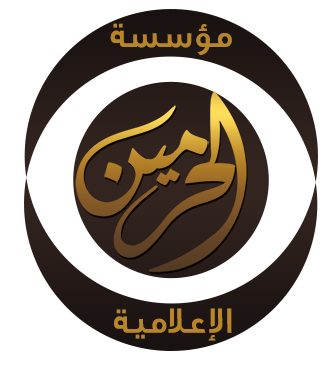
Click the following link for a safe PDF copy: The Launching of al-Ḥaramayn Media Foundation
__________
To inquire about a translation for this statement for a fee email: [email protected]
New statement from Katībat al-Zarqāwī in Bilād al-Ḥaramayn: "Founding Statement"
البيان رقم (1)ـ
بسم الله الرحمن الرحيم
الحمد لله رب العالمين القائل في كتابة الكريم (يأيها النبي جاهد الكفار والمنافقين وأغلظ عليهم) والقائل في محكم التنزيل (واقتلوهم حيث ثقفتموهم)ـ
والصلاة والسلام على أشرف الأنبياء والمرسلين قائد المجاهدين الناطق بلسان الوحي المبين (أخرجوا المشركين من جزيرة العرب)ـ
وانطلاقا من الأوامر الإلهية وحيا كان أم سنة نعلن نحن في الكتيبة الزرقاوية في بلاد الحرمين الأمر لجنودنا ببدء العمليات الجهادية ضد الرافضة المجوس على أرض الحرمين وذلك لتطهيرها من شركهم و خزعبلاتهم وكفرهم بالله وطعنهم في أمنا عائشة رضي الله عنها وسبهم لأبي بكر وعمر رضي الله عنهما في (حسينياتهم) ومجالسهم الشركية وطقوسهم الكفرية في أي مكان تقام فيه وخاصة في مكة المكرمة والمدينة المنورة لذلك ننبه لما هو آت:
1- سنستهدف كل المظاهر الشركية التي يقوم بها الروافض في بلاد الحرمين
2- سنستهدف من يداقع عنهم ويحميهم
3- سنستهدف الفنادق التي تسكنهم
4- سنستهدف السيارات التي تقلهم
وكل ماسبق تعتبر أهداف مشروعة لمفخخاتنا وللأنغماسيين الأستشهاديين الذين سيطهروا بلاد الحرمين من رجس الروافض لذلك ننبه كل من يرى هذه المظاهر الشركية بالابتعاد عنها وعدم الاقتراب منها، كما ندعوا كل مسلم موحد للأنظمام لنا والبدء بالمشاركة في العمليات كلا في منطقته .
فسيروا على بركة الله ياجنود الكتيبة الزرقاوية وتذكروا سيرة البطل الشهيد ابو مصعب الزرقاوي وكيف مرغ أنوف الرافضة توكلوا على الله واستعينوا به هو مولاكم وناصركم ونعم المولى ونعم النصير
هذا والله ولي التوفيق
عزام
(أمير الكتيبة الزرقاوية)
__________
To inquire about a translation for this statement for a fee email: [email protected]
Check out my new article in The CTC Sentinel: "The Saudi Foreign Fighter Presence in Syria"

The foreign fighter trend currently developing in Syria is unprecedented both due to the quantity of fighters as well as the number of foreign nationals involved. For Saudi foreign fighters, this trend is not new. Saudis have been involved in foreign fighting since the anti-Soviet jihad in Afghanistan in the 1980s. They played one of the most prominent roles in that war, as well as in subsequent conflicts in Chechnya, Bosnia, Afghanistan in the 1990s, Afghanistan post-9/11, and Iraq. Similarly, Saudis are one of the leading foreign national groups in Syria in terms of the total number of individuals fighting, and also among those who have died.
This article offers a brief history of Saudi involvement in past jihadist conflicts, the current statistics on how many Saudis have traveled to Syria, and highlights cases of important Saudis who have joined the war. The article finds that similar to past foreign fighter mobilizations, the Saudis have been one of the largest contingents, with some individuals taking important positions on the ground as clerics or leaders. This development could have far reaching implications. Saudi foreign fighters who join jihadist groups such as the Islamic State in Iraq and the Levant (ISIL) or al-Qa`ida’s Jabhat al-Nusra (JN) will gain tactical experience and further ideological indoctrination in Syria. Once their “tour” in Syria ends, there is a risk that these fighters could adopt al-Qa`ida’s targeting patterns and conduct attacks against the Saudi government or Western interests.
Click here to read the rest.
al-Tibīyyān Media presents a new Nashīd from Abū Talḥah al-'Almānī (Deso Dogg): "Against the Infidel Hypocrites and the Saudi Palace"

____________
